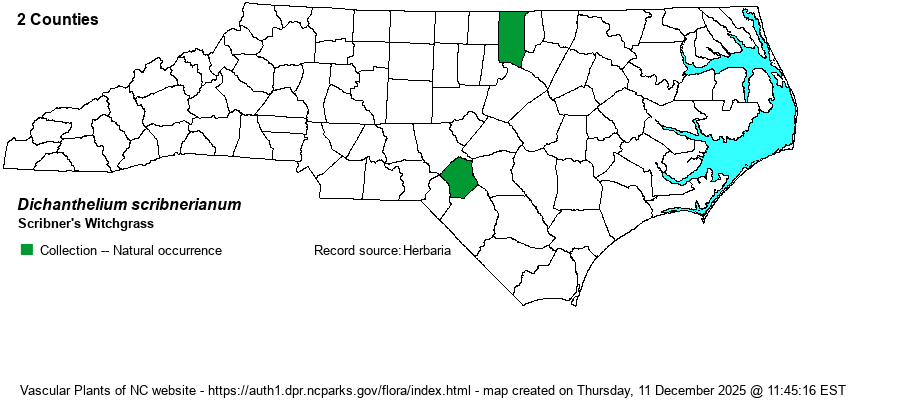| Author | (Nash) Gould | |
| Distribution | Restricted to two locations in NC, so far as is known: Picture Creek Diabase Barrens in Granville County, collected in 2001 by Richard LeBlond; and Fort Bragg (now Ft. Liberty) in Hoke County, collected in 1991 by Bruce Sorrie. There also is an historical collection (1968) from "near Creedmore" in Granville County.
These are the only county records verified in recent (2024) examinations of specimens by R.J. LeBlond.
ME to B.C., south to northern GA and CA; Mex. | |
| Abundance | Very rare. This is a Watch List species. | |
| Habitat | Open grassland with abundant forbs over mafic rock; dry upland longleaf pine-oak-wiregrass. | |
| Phenology | Flowering and fruiting late April-November. | |
| Identification | Very much like D. oligosanthes (which see), but spikelets smaller (2.7-3.5 mm vs. 3.4-4.2). | |
| Taxonomic Comments | Weakley et al. (2024) treat scribnerianum as a full species, based on research by J.R. Thomas. Thus D. scribnerianum (Nash) J.R. Thomas.
A note about Dichanthelium: This genus is not impossible to identify to species! But it takes applied effort over a period of time in order to learn the various species and what their morphological limits are. We strongly recommend that you read the introduction to the treatment in Weakley et al. (2023), written by Richard LeBlond. LeBlond has made order out of near chaos, and his keys work very well for our plants. Most Dichanthelium taxa ("Dichs") do not grow everywhere indiscrimminately, but prefer certain well-defined habitats. Note that most species produce flowers/fruits twice a year -- a vernal period and an autumnal period -- and that measurements of spikelets and achenes are taken from vernal plants. Some species also have a third, or summer, period. In the vernal period there is a single inflorescence at the tip of the stem. In the autumnal period, plants produce elongate branches with bunched (congested) leaves and so look quite different from vernal plants. Inflorescences are produced in leaf axils as well as at the tips of branches. NOTE: Older texts had these species essentially all within the very large genus Panicum. "Dich" species are typically named as "Witchgrass" and Panicum species named as "Panicgrass". | |
| Other Common Name(s) | | |
| State Rank | S1? | |
| Global Rank | G5 | |
| State Status | W7 | |
| US Status | | |
| USACE-agcp | | |
| USACE-emp | | |

